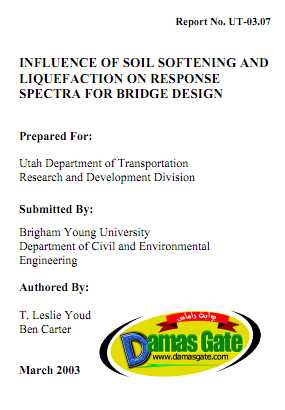Influence Of Soil Softening And Liquefaction On Response Spectra For Bridge Design

Introduction
Liquefaction has been a major cause of damage to bridges during past
earthquakes. For example, 266 railway and highway bridges were severely damaged or
collapsed due to liquefaction-induced lateral spread during the 1964 Alaska earthquake
(Youd, 1978). Similar bridge damage has occurred during many other earthquakes as a
consequence of lateral spread and other forms of ground displacement (Youd, 1993).
Damage to bridges may occur due to either of two possible consequences of liquefaction:
(1) Liquefaction may lead to large permanent ground displacements that distort and
fracture structural elements. (2) Due to soil softening within the liquefiable layer as
excess pore water pressures generate during the liquefaction process, ground response is
modified changing the spectral content of the motions for which the structure must be
designed. This paper addresses the second of these two possible deleterious effects.
In a past project, Youd et al.(1997) evaluated liquefaction-induced ground failure
hazards to bridges in Utah, using liquefaction hazard screening procedures developed by
Youd (1998). Little attention was given in that report to the influence of soil softening on
ground response. As seismic design criteria were being developed for the major I-15
reconstruction project in Salt Lake County in the late 1990’s, a major deficiency was
discovered in engineering procedures for defining ground response for sites underlain by
liquefiable layers. In the I-15 case, many bridge sites are underlain by liquefiable layers
that, because the ground surface is nearly flat, pose no ground displacement hazard. At
that time, design response spectra for the project were slightly enhanced for long-period
motions to account for possible soil softening during earthquakes. This enhancement was
Download
*